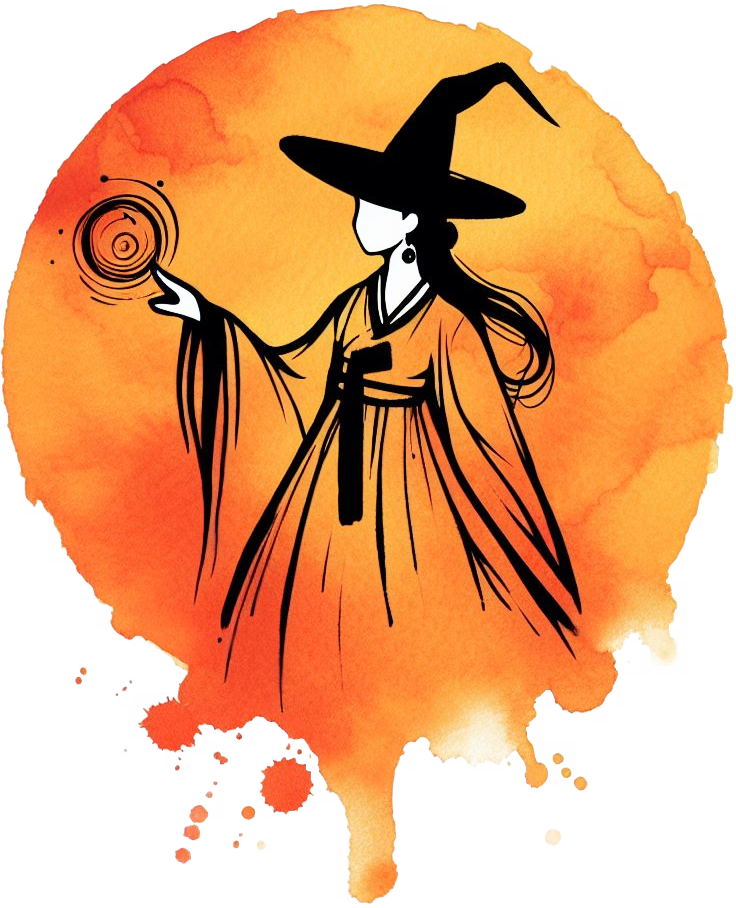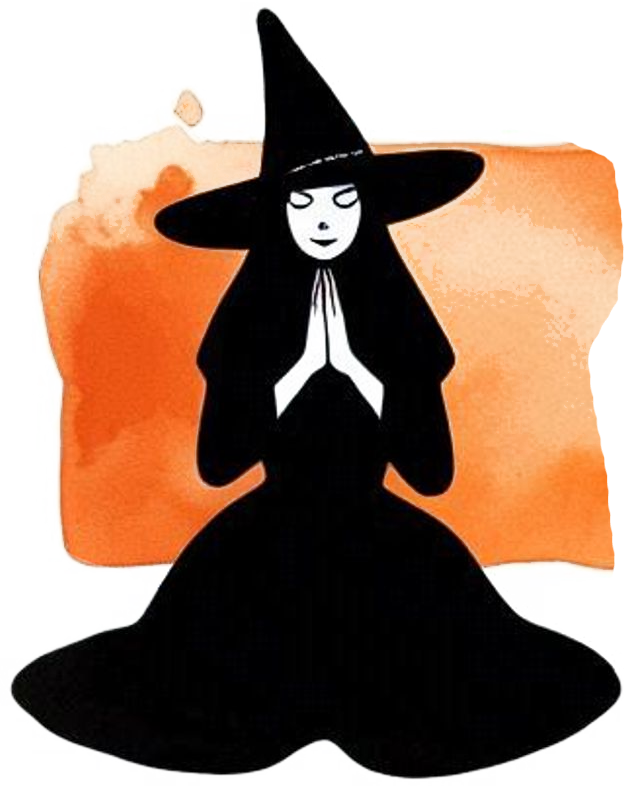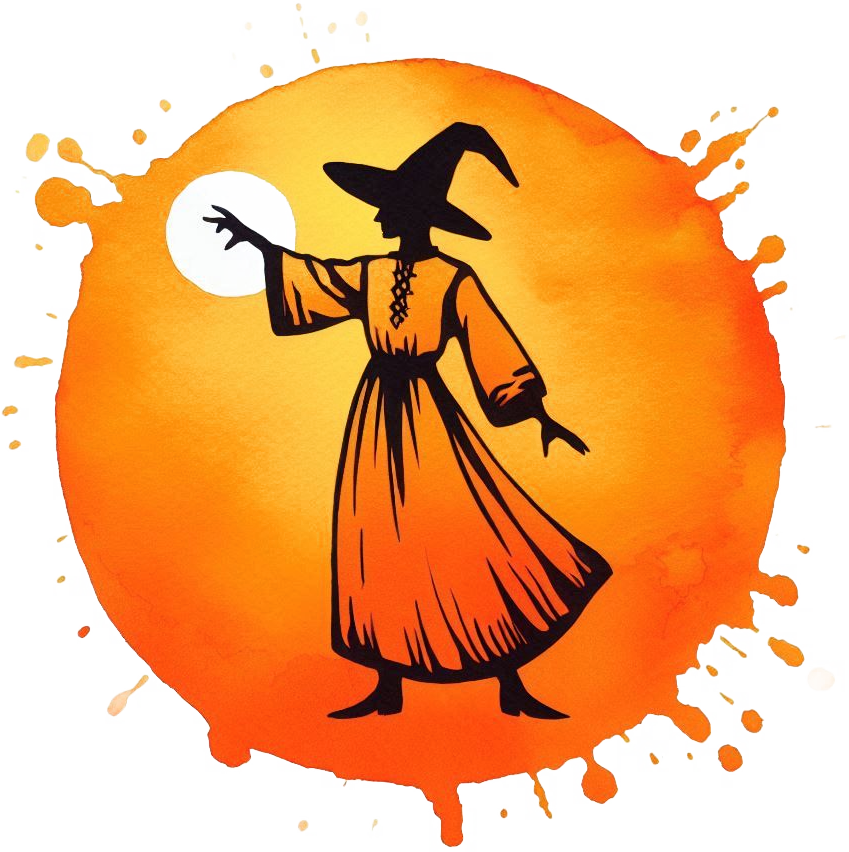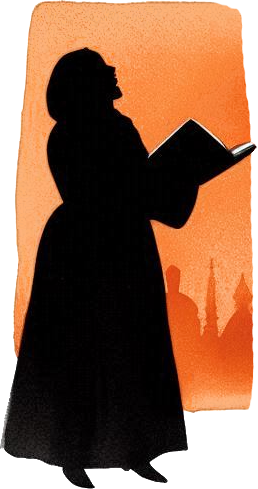
Orange. A bright color that you can't ignore. Orange is such a strong color that people love it or hate it. It has a youthful cheeriness that definitely veers into the brash and garish. Orange is not subtle. Ever. At the same time shades of orange surround us in various peach skin tones and shades of brown and we never notice that they are all variations on orange. It is the color of the second chakra in the modern 7 chakra system, and that's why it's the second page (if you're choosing to read things in the arbitrary order I'm putting them in).
Having established the physical aspects and attributes of witchcraft and the manner of who can be a witch, we continue on to considering the actions of witchcraft. What can be accomplished with spells, talismans, and the like? Usually spells use at least 2 of these 3 aspects: visualization, symbolic action, and vocalizations. Usually. There are always exceptions, of course. If you're following a particular path or tradition, you'll be taught how that group thinks of and uses witchcraft. If you have a method that is working for you, by all means, keep doing the thing that works! But if you're here because something isn't working, understanding the underlying theory might help you figure it out.
✦ meditations ✦

In most books you're going to read a lot about intention, because it's important. However, if intention is the point of the pen on the page of reality, visualization of that intention is the pen. And I have to tell you, if you want to have a focused intention powerful enough to change things, you're going to need to meditate. Meditation is like strengthening your spellcasting muscles. If you enjoy meditating on the void, that is just fine, but most people find that very discomforting. Instead of focusing on clearing your mind during meditation, try instead to focus your attention on something you know well. A small object from your pocket is a great example. If you find something is distracting you from concentrating on the image of the object you're working with do not simply try harder to ignore it. This is a message from yourself that is too subtle for you to be aware of. Your meditation space is too noisy, your body position is not comfortable, you are too hungry to meditate, etc. Try to address the issue you have been made aware of before meditating again. With practice you will know how to focus even with these things, but that is not where you should start, and far too many people do. 'No-Mind' meditation is a valid and powerful form of meditation, but it's not even where the Zen Buddhists would start.
So, on a certain level meditation is just focused thinking, and in that way it's pretty universal. The gift and curse of our species is our ability to think. But when it comes to meditating in the sense of focusing your mind upon a single point of thought, you really can't beat the wisdom from Hinduism and Buddhism. Meditation is considered a fundamental part of practice in both of these religions, as you'd expect given that fact there are a lot of writings on how to do it. A good parallel is prayer in Christianity. It is expected that most Christians will pray, so Christian scholars and sages have written a great deal on how to do it. There are Christian writings on meditation, but it is usually described with the word contemplation. This kind of deep, focused thought tends to move with ascetic traditions, and the ascetic threads of Christianity have never really caught on. Check out as many methods and philosophies of meditation as you can and use what works for your brain and you as a person.
✦ movements ✦

Movement here means different things. There are physical movements: moving from one mudra (gesture) to another, moving the body through a dance or kata, or even something simple like walking. Objects can move. We can throw them, drop them, bury them. In a more metaphorical sense, objects can be transformed. They can be burned, dissolved, torn, frozen, broken, fixed, melted, etc. Is this starting to remind you of some of the spells you've seen? The movement of a wand directing energy, the burning of a scroll, the melting of a candle.
The movement of a spell is determined by it's intention. The movement invokes the intention into the material plane. So the movement or movements chosen need to match that intention. What movement (in the broad sense) invokes the feeling of letting go? What movement invokes the feeling of abundance? Most witchcraft paths will tell you which movements correspond to which actions, but if you don't have that kind of guidance you'll need to think about what actions fit your needs with each spell.
This is where a journal for your magical workings is very helpful. You can brainstorm correspondences in it, you can keep track of the spells you create, and most importantly, you can make notes about how well the spell and each portion of it worked. That way you can build upon the successes you've had, leave the failures behind, and perfect your understanding of how your witchcraft works.
✦ mantra ✦

Chanting, rhymes, invocations, folk songs and such are all common parts of spells, as well as religious worship of all kinds. They are all, also, each in their own way, mantra. Verbal repetition is a powerful tool for focusing the mind. You can use that tool to help focus your intentions even more. Mantra itself can be the movement for your spell but it isn't required. It's also possible, with enough focus, to invoke this tool without speaking out loud. Of course that takes time and practice. In the beginning your focus will be just a small flickering flame, but with practice you can make it burn steady and bright. Verbal repetition is a glass shade to help shelter your flame from the wind. If your practice is unattached to a particular tradition or path, don't shy away from using any words that invoke the intention of your spell. The world is full of beautiful poems, songs, prayers, prose- you can use anything that moves you in your spells. If you feel stuck and just need a few words to get you going, try some song lyrics or having AI write you a poem. It works surprisingly well!
Mantra as it is used in Hinduism is more than words spoken with intention. There is a belief in Hinduism that the syllables of Sanskrit vibrate with the different energies of existence and non-existence. The letters of the alphabet are also considered sacred gifts from the divine. Hindu mantra should always be pronounced in your best approximation of the Sanskrit. Buddhist mantra can be pronounced in your own language, though the occult paths of Tibetan Buddhist Tantra also believe that the original language of the mantra vibrates with universal energies.
Hymns and prayers are also usually best in their original language, as a sign of respect to the deities involved if for no other reason. Rhymes and charms that lose any double meanings or language based jokes in translation should stay in their original language as well. Write out the phonetic spelling to read from while you are casting, and record it in your notes phonetically. Don't try to write something in language you don't know using Google translate.